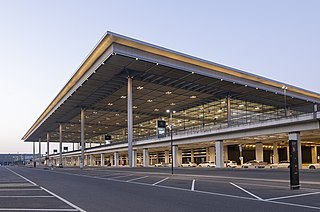
Berlin Brandenburg Airport Willy Brandt is an international airport in Schönefeld, just south of the German capital and state of Berlin, in the state of Brandenburg. Named after the former West Berlin mayor and West German chancellor Willy Brandt, it is located 18 kilometres (11 mi) south-east of the city centre and serves as a base for Eurowings, easyJet and Ryanair. It mostly has flights to European metropolitan and leisure destinations as well as a number of intercontinental services.
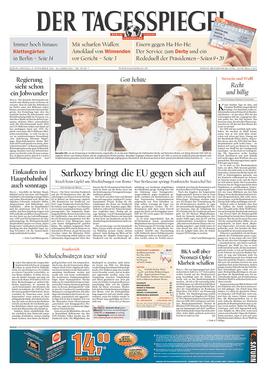
Der Tagesspiegel is a German daily newspaper. It has regional correspondent offices in Washington, D.C., and Potsdam. It is the only major newspaper in the capital to have increased its circulation, now 148,000, since reunification. Der Tagesspiegel is a liberal newspaper that is classified as centrist media in the context of German politics.
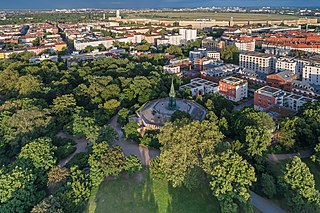
The Viktoriapark is an urban park in the locality of Kreuzberg in Berlin, Germany. It opened in 1894.
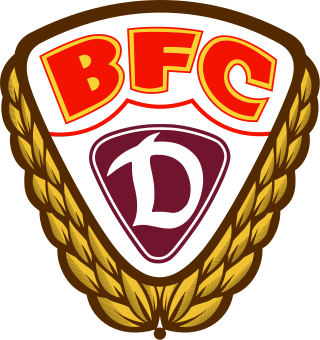
Berliner Fussball Club Dynamo e. V., commonly abbreviated to BFC Dynamo or BFC, alternatively sometimes called Dynamo Berlin, is a German football club based in the locality of Alt-Hohenschönhausen of the borough of Lichtenberg of Berlin.
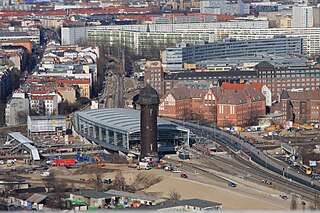
Berlin Ostkreuz station is a station on the Berlin S-Bahn suburban railway and the busiest interchange station in Berlin. It is in the former East Berlin district of Friedrichshain, now part of the borough of Friedrichshain-Kreuzberg. A smaller part of the station is in Rummelsburg, part of the borough of Lichtenberg. The station is a Turmbahnhof with the Berlin–Frankfurt (Oder) railway and the Prussian Eastern Railway on the lower level and the Berlin Ringbahn on the upper level. It is used by a total of around 235,000 passengers every day on eight lines, entering or leaving.

Sportforum Hohenschönhausen, officially named Sportforum Berlin, is a multi-purpose sports complex in the locality of Alt-Hohenschönhausen of the borough of Lichtenberg in Berlin. The Sportforum was named Dynamo-Sportforum during the East German era.
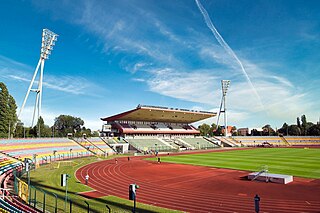
The Friedrich-Ludwig-Jahn-Sportpark is a multi-purpose sports complex located in the western part of the locality of Prenzlauer Berg in the borough of Pankow in Berlin. The sports complex covers an area of approximately 22 hectares and comprises several facilities. The main building is the Friedrich-Ludwig-Jahn-Stadion. The stadium is the third-largest stadium in Berlin, after the Olympiastadion and the Stadion An der Alten Försterei, with a capacity of approximately 20,000 seats, of which 15,000 are covered. Currently, the main tenants of the stadium are VSG Altglienicke and Berlin Thunder. Friedrich-Ludwig-Jahn-Sportpark was the venue for the 2018 World Para Athletics European Championships.

Archduke Leopold Ferdinand of Austria was the eldest son of Ferdinand IV, Grand Duke of Tuscany, and Alice of Bourbon-Parma.

Jerusalem Church is one of the churches of the Evangelical Congregation in the Friedrichstadt, a member of the Protestant umbrella organisation Evangelical Church of Berlin-Brandenburg-Silesian Upper Lusatia. The present church building is located in Berlin, borough Friedrichshain-Kreuzberg, in the quarter of Friedrichstadt. Jerusalem Church is fourth in rank of the oldest oratories in the town proper.
The Senate Reserve was a stockpile of food and other necessities which the Senate of West Berlin was required to maintain in case of another Berlin Blockade. It was dissolved after German reunification.

The Prussian National Monument for the Liberation Wars is a war memorial in Berlin, Germany, dedicated in 1821. Built by the Prussian king during the sectionalism before the Unification of Germany it is the principal German monument to the Prussian soldiers and other citizens who died in or else dedicated their health and wealth for the Liberation Wars (Befreiungskriege) fought at the end of the Wars of the Sixth and in that of the Seventh Coalition against France in the course of the Napoleonic Wars. Frederick William III of Prussia initiated its construction and commissioned the Prussian Karl Friedrich Schinkel who made it an important piece of art in cast iron, his last piece of Romantic Neo-Gothic architecture and an expression of the post-Napoleonic poverty and material sobriety in the liberated countries.
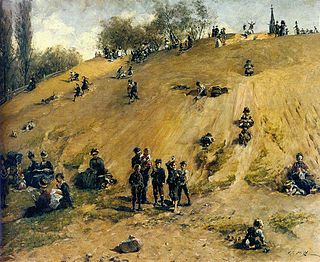
The Kreuzberg is a hill in the Kreuzberg locality of Berlin, Germany, in former West Berlin. It rises about 66 m (217 ft) above the sea level. It was named by King Frederick William III of Prussia after the Iron Cross which crowns the top of the Prussian National Monument for the Liberation Wars, designed by Karl Friedrich Schinkel, on its inauguration on 30 March 1821. On 27 September 1921 the borough assembly of the VIth borough of Berlin decided to name the borough after the hill. The borough was subsequently downgraded to a locality in 2001.

The Embassy of France in Berlin is the diplomatic mission of the French Republic in Germany. Designed by Christian de Portzamparc and completed in 2002, it is at the same address, Pariser Platz 5, as the former embassy which was destroyed in World War II. Prior to German reunification, France had an embassy in the German Democratic Republic at a different address in Berlin and an embassy in the Federal Republic in Bonn.

The Märkisches Museum is a museum in Mitte, Berlin. Founded in 1874 as the museum of the city of Berlin and its political region, the March of Brandenburg, it occupies a building on the northern edge of Köllnischer Park, facing the Spree, which was designed by Ludwig Hoffmann and completed in 1908. It is now the main facility of the Stiftung Stadtmuseum Berlin, Landesmuseum für Kultur und Geschichte Berlins, the City of Berlin museum foundation, which also operates four other sites.

The Mehringdamm is a street in southern Kreuzberg, Berlin. In the north it starts at Mehringbrücke and ends - with its southernmost houses already belonging to Tempelhof locality - on Platz der Luftbrücke. It is the historical southbound Berlin-Halle highway, now forming the federal route 96. The main junction of Mehringdamm is with the 19th-century ring road around Berlin's inner city, named Yorckstraße west, and Gneisenaustraße east of Mehringdamm.
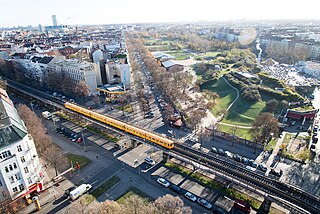
Görlitzer Park is a major park and recreation area in the Kreuzberg district of Berlin. The 14-hectare park area contains, among other things, a petting zoo, several sports and football fields, and a small lake. At its north-west end is the Görlitzer Bahnhof U-Bahn station.
Über den Tellerrand is a nonprofit organization engaged in the integration of refugees. The headquarters of the organization is in Berlin, Germany. It was founded in April 2014. The main focus of the organization is to have citizens and refugees live and work together side by side with each side learning from the others. In July 2017 the organization was active in 25 cities in Germany, Austria, Switzerland and the Netherlands.
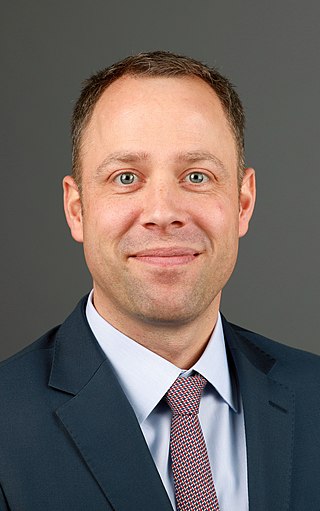
Mario Czaja is a German politician of the Christian Democratic Union (CDU) who has been serving as a member of the German Bundestag since the 2021 elections.

Mehringhof is a socialized building complex in Kreuzberg, Berlin, designed as a center for alternative activities. As of 1991, it hosted 38 projects, including a theater, an electronics collective (Wuseltronick), a printing collective, and a school for adults.

Julius Klausner was the founder of the Leiser shoe company.




















